Effective communication data security is essential for protecting sensitive information and ensuring compliance with regulations. Strategies such as end-to-end encryption, multi-factor authentication, and data loss prevention tools play a crucial role in safeguarding data during transmission and storage. By leveraging specialized tools and adhering to regulatory standards, organizations can significantly reduce the risk of unauthorized access and data breaches.

What are the best communication data security strategies?
The best communication data security strategies include end-to-end encryption, multi-factor authentication, data loss prevention tools, and regular security audits. These methods collectively enhance the protection of sensitive information during transmission and storage, ensuring compliance with relevant regulations.
End-to-end encryption
End-to-end encryption (E2EE) ensures that only the communicating users can read the messages. In this method, data is encrypted on the sender’s device and only decrypted on the recipient’s device, preventing unauthorized access during transmission.
To implement E2EE, choose communication platforms that support this feature, such as Signal or WhatsApp. Be aware that while E2EE significantly enhances security, it may complicate data recovery in case of lost access to devices.
Multi-factor authentication
Multi-factor authentication (MFA) adds an extra layer of security by requiring two or more verification methods before granting access. This could include something you know (a password), something you have (a smartphone), or something you are (biometric data).
Implement MFA across all communication platforms to reduce the risk of unauthorized access. Common pitfalls include relying solely on SMS for verification, which can be vulnerable to interception. Instead, consider using authenticator apps or hardware tokens for better security.
Data loss prevention tools
Data loss prevention (DLP) tools help organizations monitor and protect sensitive information from unauthorized access or leaks. These tools can identify, monitor, and control data transfers, ensuring compliance with regulations like GDPR or HIPAA.
When selecting DLP solutions, consider features like real-time monitoring, policy enforcement, and incident response capabilities. Regularly update your DLP policies to adapt to new threats and ensure they align with your organization’s data security goals.
Regular security audits
Conducting regular security audits is essential for identifying vulnerabilities in communication systems. These audits assess the effectiveness of current security measures and help organizations stay compliant with industry standards.
Schedule audits at least annually and after significant changes to your communication infrastructure. Utilize third-party security experts for an unbiased evaluation and ensure that audit findings lead to actionable improvements in your security posture.
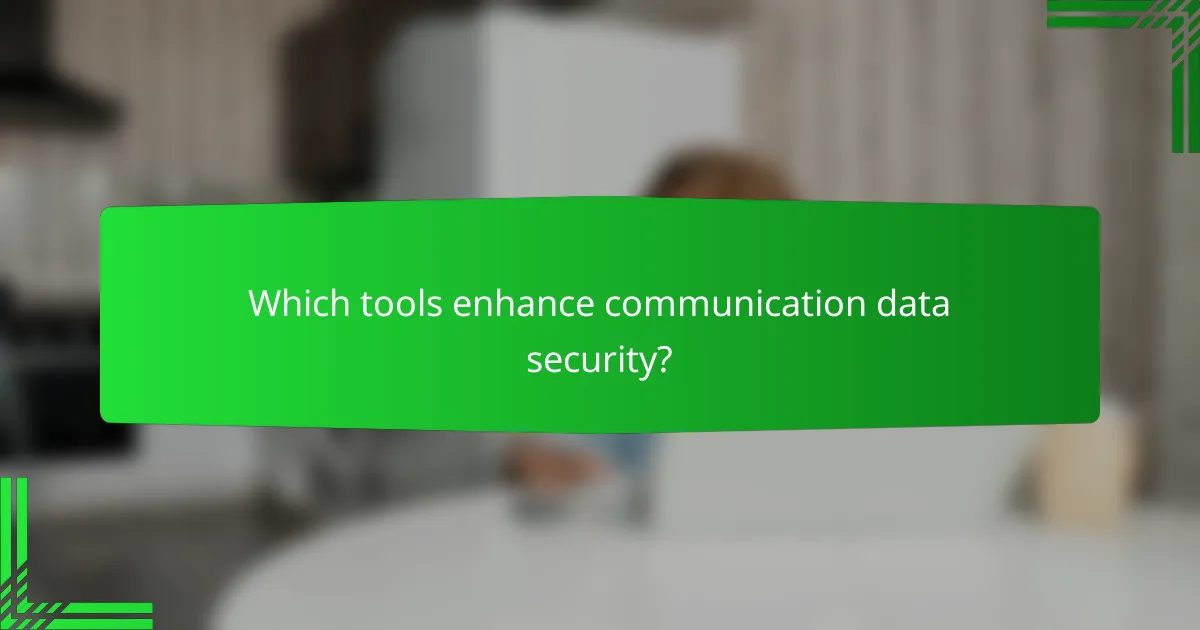
Which tools enhance communication data security?
Several tools significantly enhance communication data security by providing encryption, secure messaging, and password management. Utilizing these tools helps protect sensitive information from unauthorized access and ensures compliance with data protection regulations.
Signal for secure messaging
Signal is a popular messaging app known for its strong encryption protocols that ensure private conversations. It uses end-to-end encryption, meaning only the sender and recipient can read the messages, not even Signal itself.
When using Signal, users should enable features like disappearing messages and screen security to further enhance privacy. Regular updates and a user-friendly interface make it a reliable choice for secure communication.
ProtonMail for encrypted email
ProtonMail offers a secure email service that uses end-to-end encryption to protect user data. Emails sent between ProtonMail users are automatically encrypted, making it difficult for third parties to access the content.
For added security, ProtonMail allows users to send encrypted messages to non-ProtonMail addresses using a shared password. This feature is useful for communicating securely with contacts who do not use the service.
LastPass for password management
LastPass is a password manager that securely stores and encrypts passwords, making it easier to manage multiple accounts without compromising security. It uses strong encryption standards to protect user data both at rest and in transit.
To maximize security, users should enable two-factor authentication and regularly update their master password. LastPass also offers a security challenge feature to help identify weak or reused passwords, enhancing overall account safety.
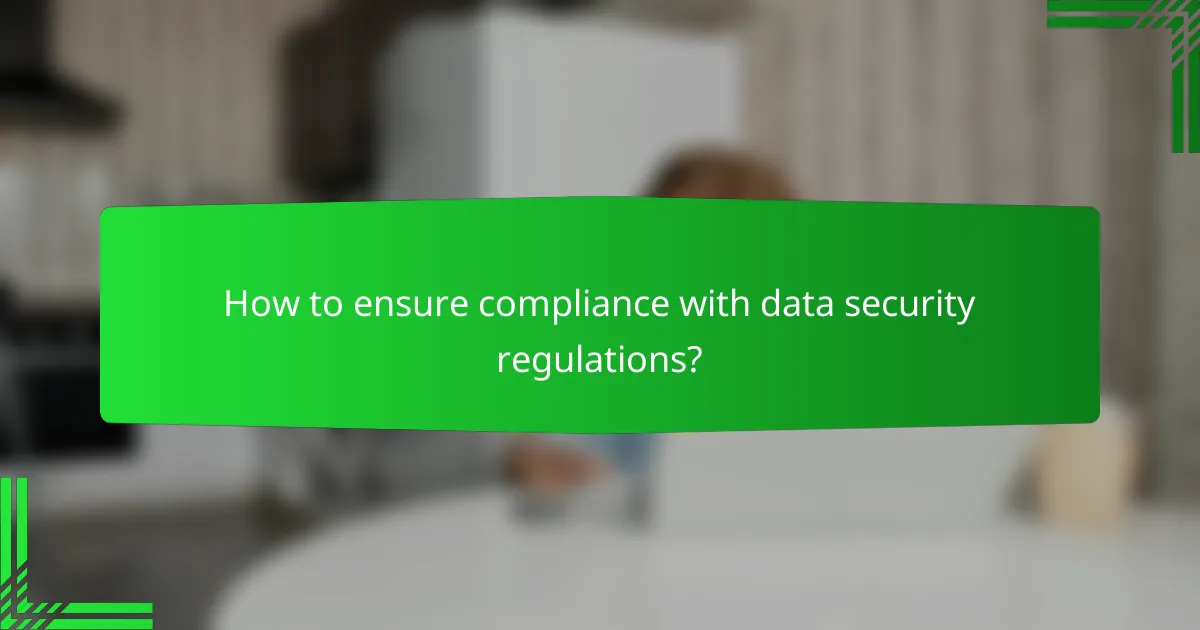
How to ensure compliance with data security regulations?
Ensuring compliance with data security regulations involves understanding the specific laws applicable to your organization and implementing necessary measures to meet those standards. Key steps include conducting regular audits, training staff, and maintaining clear documentation of data handling practices.
GDPR compliance frameworks
The General Data Protection Regulation (GDPR) requires organizations handling EU citizens’ data to follow strict guidelines on data protection. Key components include obtaining explicit consent for data processing, ensuring data portability, and implementing the right to be forgotten.
To comply, businesses should conduct a Data Protection Impact Assessment (DPIA) to identify risks and establish measures to mitigate them. Regularly updating privacy policies and ensuring transparency with users about data usage is also essential.
HIPAA guidelines for healthcare
The Health Insurance Portability and Accountability Act (HIPAA) sets standards for protecting sensitive patient information in the healthcare sector. Covered entities must ensure the confidentiality, integrity, and availability of electronic protected health information (ePHI).
Key practices include implementing access controls, conducting risk assessments, and ensuring secure communication channels. Healthcare organizations should also train employees on HIPAA requirements to minimize the risk of data breaches.
Regular compliance training programs
Regular compliance training programs are vital for maintaining awareness of data security regulations among employees. These programs should cover relevant laws, organizational policies, and best practices for data protection.
Training should be conducted at least annually, with additional sessions offered when regulations change or when new employees are onboarded. Utilizing interactive training methods, such as workshops or online modules, can enhance engagement and retention of information.
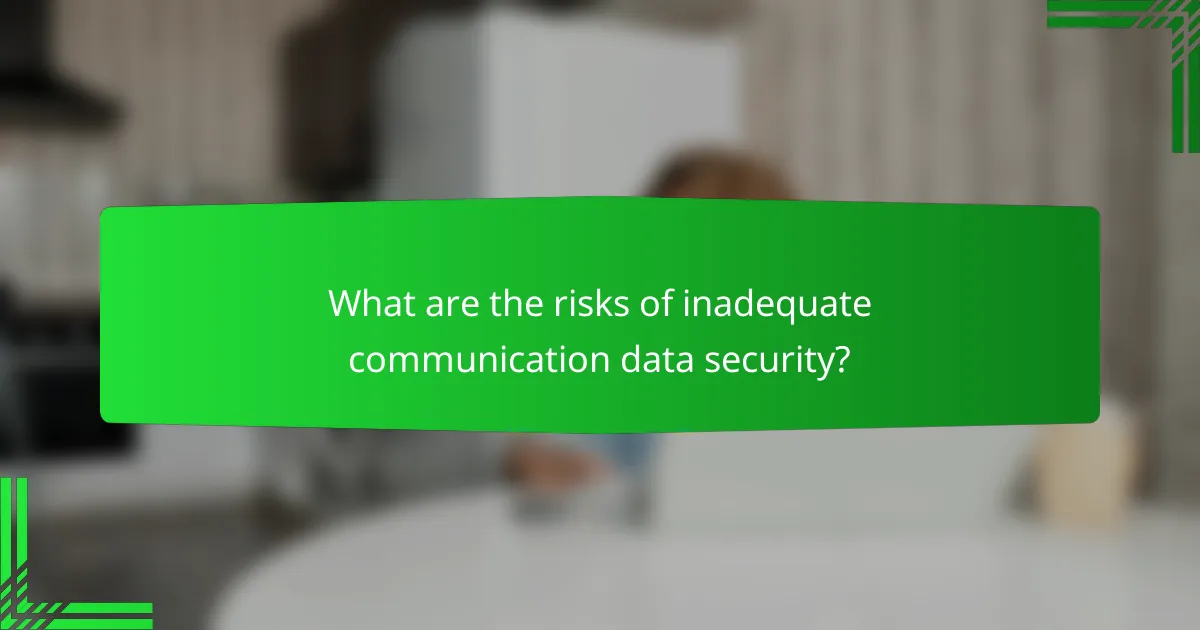
What are the risks of inadequate communication data security?
Inadequate communication data security can lead to significant vulnerabilities, including unauthorized access to sensitive information and potential exploitation by malicious actors. Organizations must be aware of these risks to implement effective security measures and protect their data integrity.
Data breaches
Data breaches occur when unauthorized individuals gain access to confidential information, often resulting in the exposure of personal or financial data. These incidents can arise from weak passwords, unpatched software vulnerabilities, or phishing attacks. Organizations should regularly assess their security protocols to identify and mitigate potential weaknesses.
To minimize the risk of data breaches, companies should employ encryption, multi-factor authentication, and regular security audits. Additionally, staff training on recognizing phishing attempts can significantly reduce the likelihood of successful attacks.
Loss of customer trust
When communication data security is compromised, customer trust can erode quickly. Clients expect their personal information to be handled securely, and any breach can lead to skepticism about an organization’s reliability. This loss of trust can result in decreased customer loyalty and potential revenue loss.
To rebuild trust after a security incident, organizations should communicate transparently with affected customers, outlining the steps taken to address the breach and prevent future occurrences. Offering credit monitoring services can also help reassure customers about their data security.
Legal penalties
Inadequate communication data security can expose organizations to legal penalties, particularly if they fail to comply with data protection regulations such as GDPR or CCPA. Non-compliance can lead to hefty fines, which may range from thousands to millions of dollars, depending on the severity of the violation.
To avoid legal repercussions, businesses should stay informed about relevant regulations and ensure their data security practices align with legal requirements. Regular compliance audits and employee training on data protection laws can help mitigate the risk of penalties.
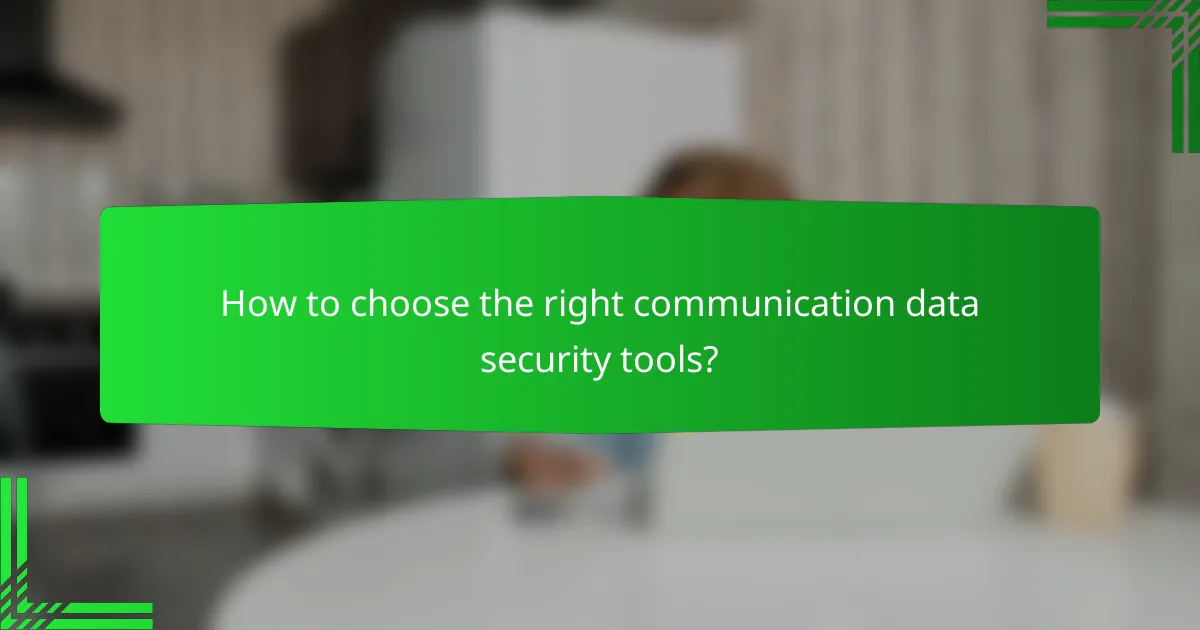
How to choose the right communication data security tools?
Choosing the right communication data security tools involves assessing integration capabilities, user-friendliness, and scalability. These factors ensure that the tools not only protect sensitive information but also fit seamlessly into your existing workflows.
Assess integration capabilities
Integration capabilities are crucial for ensuring that your communication data security tools work well with existing systems. Look for tools that can easily connect with your current software, such as email platforms, file-sharing services, and customer relationship management (CRM) systems.
Consider tools that offer APIs or pre-built integrations, which can save time and reduce the risk of data silos. A well-integrated tool can enhance overall security without disrupting daily operations.
Evaluate user-friendliness
User-friendliness is essential for encouraging adoption among team members. Tools that are intuitive and easy to navigate will minimize training time and reduce the likelihood of user errors that could compromise data security.
Look for features such as clear dashboards, straightforward setup processes, and accessible customer support. Conducting a trial run with potential tools can help gauge how user-friendly they are in practice.
Check for scalability
Scalability ensures that your communication data security tools can grow with your organization. As your team expands or your data needs evolve, the tools should be able to accommodate increased usage without sacrificing performance.
Evaluate whether the tools offer tiered pricing plans or additional features that can be activated as needed. This flexibility can help manage costs while ensuring robust security as your operations scale.
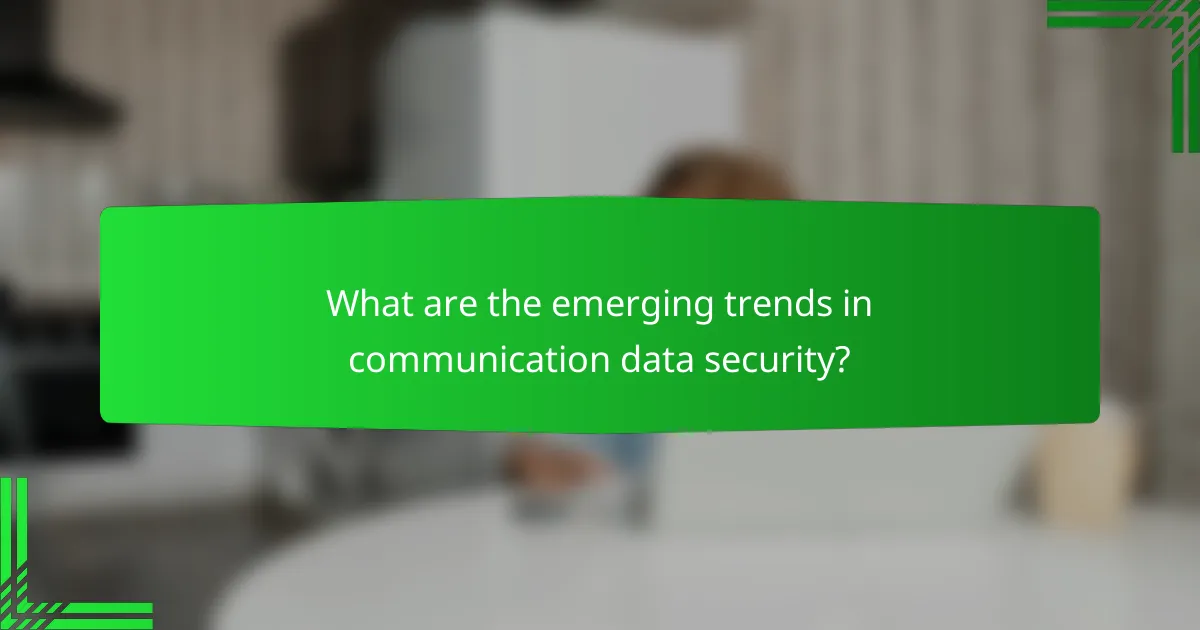
What are the emerging trends in communication data security?
Emerging trends in communication data security focus on enhancing protection against evolving threats while ensuring compliance with regulations. Key areas include the adoption of advanced encryption technologies, increased use of artificial intelligence for threat detection, and a stronger emphasis on user privacy.
Advanced Encryption Techniques
Advanced encryption techniques are becoming essential in safeguarding communication data. These methods include end-to-end encryption, which ensures that only the communicating users can read the messages, and homomorphic encryption, allowing computations on encrypted data without needing to decrypt it first.
Organizations should consider implementing these techniques to protect sensitive information. For example, using end-to-end encryption in messaging apps can significantly reduce the risk of data breaches. However, it is crucial to balance security with usability to avoid hindering communication flow.
Artificial Intelligence in Threat Detection
Artificial intelligence (AI) is increasingly utilized for threat detection in communication data security. AI systems can analyze vast amounts of data in real-time, identifying unusual patterns that may indicate a security breach or cyberattack.
Companies should invest in AI-driven security solutions that can adapt to new threats quickly. For instance, machine learning algorithms can improve over time, becoming more effective at identifying potential vulnerabilities. However, organizations must ensure they have the necessary expertise to manage and interpret AI outputs effectively.
Privacy Regulations and Compliance
Privacy regulations, such as the General Data Protection Regulation (GDPR) in Europe and the California Consumer Privacy Act (CCPA) in the United States, are shaping communication data security practices. These regulations require organizations to implement robust data protection measures and ensure transparency in data handling.
To comply with these regulations, businesses should conduct regular audits of their data security practices and provide clear privacy policies to users. This includes informing users about data collection, storage, and sharing practices. Non-compliance can result in significant fines, making adherence to these regulations critical for organizations operating in affected regions.
